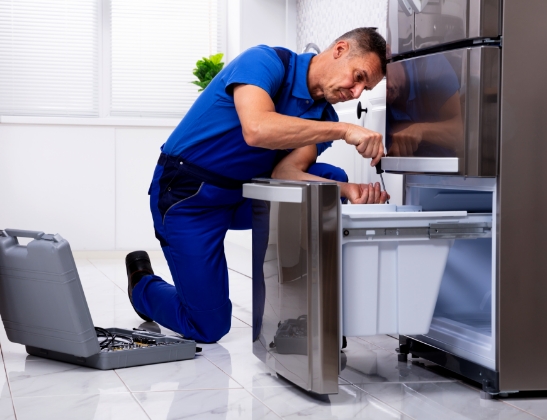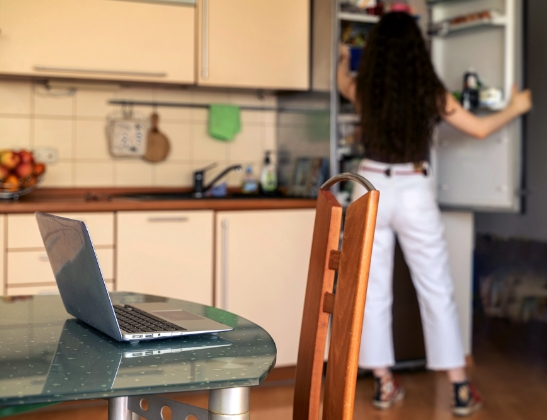Refrigerator Troubleshooting: How To Fix a Fridge
Posted: January 25, 2024
A functioning refrigerator is essential for feeding your family and getting everyone through the day. When something goes wrong, it can feel like an emergency. Thankfully, the solution may be simpler than you thought and even something you can do yourself.
Use this guide to help you pinpoint the problem and try a few refrigerator troubleshooting steps to repair it. If you find that these solutions aren't addressing the issue, then you'll know you need a professional. Read on to learn how to diagnose and fix common refrigerator problems.

Before You Begin: Read The Manual
Before you start tinkering or taking things apart, consult your owner’s manual. Most manuals will have troubleshooting steps right in them so you can get model-specific instructions. Many refrigerator issues will have simple fixes or at least a simple way to diagnose the problem. Some problems will require professional help, but you won’t know until you try a few things first, so run through these DIY fixes before scheduling a service call.
Common Refrigerator Problems and Solutions
Poor Ice Production or Quality
If your icemaker isn’t making as much ice as you expect or the ice is too small or hollow, the solution may be simple. If you’ve just installed your refrigerator, keep in mind that it will take 24 hours for ice production to begin and 72 hours for full ice production. If you’ve recently removed a large amount of ice, it can take around 24 hours to fully replenish. Before beginning to troubleshoot, check that the icemaker wasn’t turned off accidentally.
- Check the water line. Your icemaker could not be getting enough water. Make sure it’s connected to a water supply by checking the water line connection in the back of the fridge. If it’s securely connected, run down the line to check for kinks.
- Open the water valve fully. Locate the water shutoff valve - it’s usually in the wall behind the fridge (sometimes hidden in a panel), under the sink, or in the cabinet next to the refrigerator. Make sure the valve is fully open by turning it counterclockwise.
- Remove the water filter. Remove the water filter and wait a few hours or up to a full day. If ice volume improves, then that means the filter may be clogged or incorrectly installed. Replace the filter or reinstall it correctly. Learn more about how to check the water filter.
The Refrigerator is Not Cooling
Before taking any action, consider if the power has recently gone out or a large amount of food has been added. If so, it can take several hours for the temperature to return to normal. Similarly, if the refrigerator has just been installed, it can take 24 hours to completely cool.
- Ensure the settings are right. Some refrigerators have a cooling setting that needs to be turned on for the refrigerator to get cold.
- Check if it’s been turned off accidentally. If you’ve just installed the refrigerator, check if it’s still in Showroom or Demo mode; consult the Use and Care Guide to learn how these settings turn on and off.
- If none of the previously listed things are true, turn the temperature setting colder and wait 24 hours for the temperature to adjust.
- Check for blocked air vents. In order to ensure proper temperature, you need to allow room for adequate airflow between the freezer and refrigerator compartments. Cool air enters and exits the refrigerator compartment from the freezer through vents located in both the refrigerator and freezer. Make sure there are no food items blocking these vents. See where your vents might be located.
- Clean the condenser coils. There is typically no need for routine condenser cleaning in a normal home environment. However, if the environment is particularly greasy or dusty, or there is significant pet traffic in the home, the condenser should be cleaned every 2 to 3 months to ensure proper cooling. Watch a video on how to clean the condenser coils.
The Refrigerator Motor Seems to Run Too Much
If your refrigerator is new, it may have a high-efficiency compressor that optimizes energy and better regulates temperatures to match cooling demand. You may notice that it operates differently than your previously owned refrigerator. It is usual for the high-efficiency compressor to run for extended periods at varying speeds to consume only the energy necessary for optimum efficiency.
- Check the refrigerator’s installation. Most refrigerators are designed to be used in a location where the temperature ranges from a minimum of 55°F (13°C) to a maximum of 110°F (43°C).
- They should not be installed near a heat source like an oven or radiator. A location that is too hot or too cold could cause the refrigerator motor to work too hard.
- Make sure there’s enough room around the refrigerator for proper ventilation, according to your owner’s manual.
- Keep the doors closed as much as possible. Opening doors too much or leaving them open for long periods of time will cause the temperatures inside to rise, making the motor work overtime to drop the temperature down again.
- Check the door seal to ensure it makes full contact with the refrigerator. If not, try wiping it down to remove any debris or obstructions.
- Set the controls correctly. Temperature controls are typically preset at the factory to the "mid setting," which should be correct for regular household use. The controls are set correctly when beverages are as cold as you would like. Setting the controls too low can cause the refrigerator to run longer than it needs to. Learn more about how to get the correct temperature settings.
The Water Dispenser is Not Working Properly
Whether your water dispenser is leaking, dispensing too slowly or dispensing cloudy water, the solutions will most likely be similar. Follow these troubleshooting steps to get to the bottom of most water dispenser problems.
Check the water filter. A clogged or incorrectly installed water filter will reduce the water flow to the dispenser and slow down dispensing. Check for a problem with the filter by doing the following:
- Dispense water and note the amount of water flow.
- Remove the filter. The filter is located either in the base grille below the refrigerator compartment door or inside the refrigerator compartment.
- Dispense water with the filter removed. If the water flow noticeably increases, the filter is either clogged or incorrectly installed. A clogged filter will need to be replaced in order to correct the low flow. Learn how to replace the filter.
- Flush the water system. Flushing the system is needed every time the filter is changed or once the refrigerator is installed to the water supply line for the first time. The air in the water system may cause dripping at the dispenser, that is considered a leak or for the water to dispense slowly. Get step-by-step instructions on how to flush the water system.
- Check the water pressure. Your water pressure should be between 30 and 120 psi. If it’s lower than that, a problem with the water supply connection or a clogged filter could be the culprit. A reverse osmosis system can contribute to low water pressure as well. Learn more about low water pressure and how to correct it.
The Refrigerator Seems Loud and Noisy
Refrigerators and freezers make a variety of normal operating sounds, but you may not have heard them all before. These sounds may come from behind the refrigerator, inside the fridge or freezer compartment, or from the ice maker. It’s important to know which noises are normal and which indicate a problem. Get a full run-down of refrigerator noises, what they mean and how to fix them with this refrigerator noises guide.
Do I need a professional to fix my refrigerator?
If your attempts to troubleshoot your refrigerator have proven unsuccessful and the issues persist, consulting a professional technician is the next step towards resolving complex problems and ensuring the long-term functionality of your appliance.
Remember, timely professional intervention can save you both time and potential further damage to your refrigerator. Give our repair specialists a call to see if we can be of service. Our appliance parts and servicing store is located in Fond du Lac, Wisconsin.
Is It Time For a New Refrigerator?
At Silica, your trusted appliance store in Wisconsin, we understand the pivotal role a refrigerator plays in your home. If you've found yourself grappling with recurring issues or your current fridge just doesn't meet your needs anymore, it might be the perfect time to upgrade to a new and advanced model. We offer some of the best French door, bottom freezer, side-by-side, top mount, built-in, and counter-depth refrigerators for sale.
Our knowledgeable staff is ready to assist you in making an informed decision. Whether you are in the market for household appliances, electronics, furniture, or mattresses, we're here to guide you every step of the way.
Explore a diverse range of appliances from leading brands, ensuring you find the perfect fit for your kitchen and lifestyle. If you are looking for appliance repairs near you, get in touch with our experts to get repairs on your refrigerator, upright freezers, wine cooler fridges, deep freezers, mini-fridges, or any other type of kitchen appliances.
Don't let refrigerator troubles disrupt your daily life. Visit Silica today and explore a world of premium refrigeration options!
Related Readings:
Refrigerator Troubleshooting Commonly Asked Questions
The refrigerator light is not turning on. What should I check?
Check the light bulb for any signs of damage or replace it with a new one. If the issue persists, inspect the door switch, which may require adjustment or replacement.
How often should I clean the condenser coils on my refrigerator?
Regularly cleaning the condenser coils is recommended, typically every six months or as needed. Accumulated dust and debris can hinder heat dissipation, affecting the refrigerator's performance.
The refrigerator is leaking water. What could be causing this?
Leaks may result from a damaged water line, a clogged defrost drain, or issues with the water tank assembly. Investigate these components to identify and resolve the cause of the leakage.
Do you repair appliances in all of your store locations?
No, we only do appliance repairs in our 44 Zeller Court Fond du Lac, WI 54937 store location.



Be The First To Know
Sign up to get access to deals, inspiration, trends, and more!







